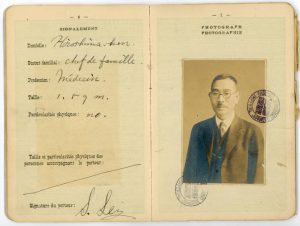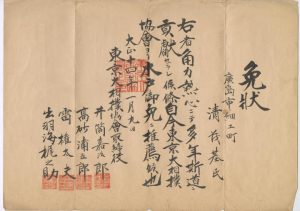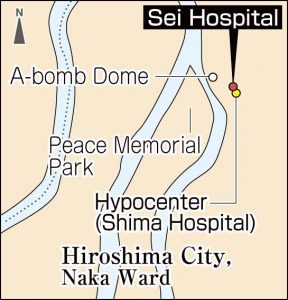Striving to fill voids in Hiroshima, evidence of victims remains—Passport of physician who died at hypocenter reveals journey around world for research
Sep. 15, 2022
Also promoted sports like sumo and baseball with own money
by Kyosuke Mizukawa, Senior Staff Writer
A passport and other keepsakes that once belonged to Shigemoto Sei, a physician who was killed in the atomic bombing at the age of 63, had been held on to by a family member. Mr. Sei worked at a hospital in the area of Saiku-cho (present-day Otemachi in Hiroshima’s Naka Ward), located right below the detonation of the atomic bomb dropped by the U.S. military. Mr. Sei’s medical research took him overseas to several western nations, and he did his part to contribute to the development of sports in Hiroshima. The Hiroshima Peace Memorial Museum, in the city’s centrally located Naka Ward, will display Mr. Sei’s keepsake items at a special exhibit that starts September 16 to convey the path he traveled during his lifetime, information that is known to few people now.
Mr. Sei studied medicine at Tokyo Imperial University Medical College (now the Faculty of Medicine at the University of Tokyo) and opened Sei Hospital, which housed such departments as urology and dermatology, in Hiroshima’s Saiku-cho in 1912. His hospital was located kitty-corner from Shima Hospital (now Shima Hospital of Internal Medicine), located in the hypocenter area. During the war, as the hospital continued to treat patients, an advertisement for his medical practice that read “Sei Hospital, Director Shigemoto Sei” was run in the Chugoku Shimbun newspaper published on August 6, 1945.
However, that same day, Sei Hospital was completely destroyed and incinerated by the powerful blast and thermal rays from the A-bomb in its location just below the bomb’s detonation in the air above Hiroshima. The remains of Mr. Sei’s body were found in the ruins of his medical exam room. Because his oldest son, Kunizo, then 18 and a first-year student at Hiroshima Prefectural Medical School (now Hiroshima University School of Medicine), was also killed in the bombing, the hospital was not rebuilt.
Mr. Sei owned another house in the district of Kusatsu-cho (now part of Hiroshima’s Nishi Ward). Junji Sei, 87, Shigemoto’s grandson who lives in Mino, Osaka, has held on to his grandfather’s passport that had been left in the home. When the museum examined the passport, it found that Mr. Sei had traveled around the world in 1928, first crossing the Pacific Ocean to visit the United States, then dropping by the United Kingdom and France, and passing through the former Soviet Union. The purpose of his journey is indicated in the document as work related to medical research, among others.
Among his keepsakes besides the passport is a certificate (issued January 9, 1925) by which the Tokyo Sumo Association (now known as the Japan Sumo Association) provided to Mr. Sei free admission to sumo tournaments. Mr. Sei loved the sport of sumo so much that he offered his own support for the holding of sumo tournaments in Hiroshima. When the tournaments were held in the city, stories have it that ranking sumo wrestlers would visit him one after the other. He also was very fond of baseball. According to the Shinshu Hiroshima City History (published in 1958), he took the lead in constructing the Kanon Grounds, a baseball stadium that was erected in a part of Hiroshima’s current Nishi Ward in 1919, offering his own financing for the project. It was the city’s first full-fledged baseball facility, with more than ten rows of wooden seats, and baseball fans in those days were said to have been admiring of him.
Starting on September 16, the museum is scheduled to hold a special exhibit related to the area in Hiroshima known as Saiku-machi. In April, while preparations were underway for the exhibit, the Chugoku Shimbun had the opportunity to interview Junji Sei regarding the photo of Sei Hospital taken after the atomic bombing. At that time, it was found that he had been holding on to his grandfather’s keepsakes. When the museum learned of the presence of the items, it asked Junji to provide them for the exhibit, and he accepted the request without hesitation. “It would comfort my grandfather’s soul,” said Junji.
Hironobu Ochiba, the museum’s chief curator, said, “The keepsakes are valuable materials for understanding what kind of people perished in the atomic bombing in the Saiku-cho area. Since Sei Hospital was obliterated in the atomic bombing and few people know about Mr. Sei now, we are hoping to convey the story of his life through our exhibit.”
(Originally published on September 15, 2022)










